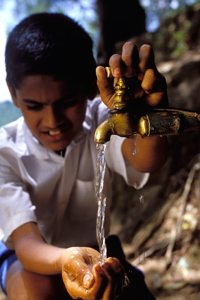Research Brief
Every Drop Counts – Improving Aid to Water and Sanitation
- Each dollar of aid per year provides 0.17 people with access to water or sanitation. This amounts to a cost of US$5.88 per person.
- Due to economies of scale, countries with large populations benefit more from aid to the water and sanitation sectors.
- Institutional reforms that facilitate the participation of the private sector in the provision of public services tend to increase aid effectiveness in water and sanitation.
- Aid can play a role in strengthening institutions, increasing information about the quality of water and sanitation services, and by influencing utilities to provide water to the poor.
One of the aims of overseas development assistance is to make a positive difference to the lives of the poor and vulnerable. Improving the access to safe drinking water and sanitation systems can play a significant role in achieving this aim. However, there are several challenges when it comes to scale up and replicate policy successes.
Improvements in water and sanitation infrastructure are important for a number of reasons. Firstly, they contribute directly to saving lives, secondly, they contribute to improving quality of life, and thirdly, they produce positive spillover effects in terms of improved school attendance and educational performance, and improved productivity for workers via better health status.

The effectiveness of aid to water and sanitation
The proportion of people having access to water increased from 77 per cent in 1990 to 83 per cent in 2002 and the proportion of those with access to sanitation increased from 49 per cent in 1990 to 58 per cent in 2002. The number of people provided with improved water between 1990 and 2000 was 991 million, and those provided with sanitation was 955.85 million. During the same period the total amount of aid to the water and sanitation sector for these countries was estimated to be 11.14 billion dollars. Thus it cost approximately US$5.88 per person to provide access to water or sanitation.
Two key factors seem to play a role in determining the effectiveness of aid to water and sanitation: population size and the extent to which the water and sanitation facilities and infrastructure are provided by the private sector. Countries with large populations and greater levels of participation of the private sector in the provision of public services seem to benefit more from aid to water and sanitation. Population size is important because the larger the population the greater the economies of scale in providing water and sanitation services.
The positive relationship between privatization and aid effectiveness is also associated with institutional reforms. Countries with high levels of private involvement in social sector infrastructure in the 1990s introduced institutional reforms that are likely to have contributed to improve aid effectiveness.
Key challenges in scaling up and replicating successes
Long-term vs. pro-poor solutions
Investing in piped water supply and sanitation represents a more long-term approach to social service provision. However a strong emphasis on piped water supply may in fact contribute to exaggerating inequality by channeling resources towards services for the middle class who usually live in urban areas where piped water is available in developing countries. This is an important issue for donors: those investments which will most benefit the poor will not necessarily be the investments that are most long-term in nature.
Professionalization
The professionalization of water utilities can definitely contribute to improving financial and operational performance. However at the same time this can also cause the utilities to focus primarily on revenue generating water and neglect the social obligation of providing water supply to poor households who may not be able to afford to pay. Aid can play a role in influencing water utilities and in promoting appropriate indicators to distinguish clearly non-revenue water in terms of wastage, leaks and losses from water allocated to equality-enhancing social obligations.

Increasing information
Previous studies suggest that investing in capital intensive water treatment plants does not prevent households from taking precautionary measures themselves. Poor households may continue to boil water, use filtering devices, or rely on bottled water despite improvements in the quality of the water they have access to. Improving the reliability and trust-worthiness of water utilities amongst their consumers is essential before they can begin to enjoy the benefits of expensive water treatment plants. Unfortunately there is often a bias in favour of funding shiny new treatment plants rather than undertaking the painstaking work of communication and stakeholder engagement that is needed to build consumer confidence and trust.
- There is a clear need to develop water quality indicators and mainstream these for benchmarking the performance of water utilities and ultimately connect this with allocating and delivering aid.
- Much of the success in delivering water and sanitation systems may lie outside the sector in terms of improving institutional environment and reducing corruption.
Institutional strengthening
Consequent to water and sanitation being recognized as human rights, it is necessary to evaluate the extent to which institutions responsible for securing these rights have been created or strengthened and the extent to which such rights are being enforced by law. Aid can play a role in both directly improving the administrative capacity to deliver public services and indirectly, by supporting the channels through which access to water and sanitation can be facilitated, including the role of the civil society.
 Join the network
Join the network